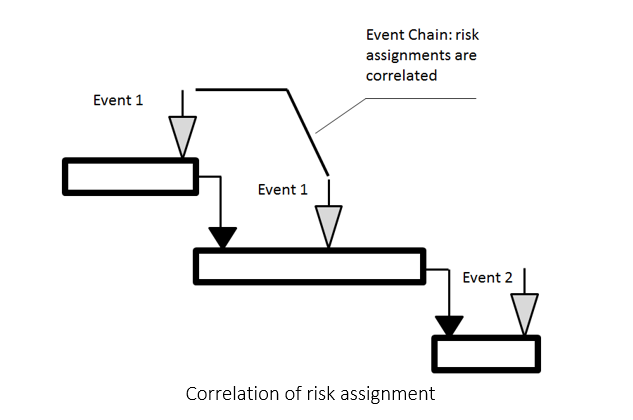In the our previous blog discussing event chains, we saw how one event can trigger a whole chain of events. However, this scenario may not be always the case. There are several different types of event chains:
1. Risks are independent. If one risk occurs, it would not affect another risk and vice versa. For example, risks related to project financing would not have any relationship with technological risks. Please note that although risks can be independent, risk assignments can be fully correlated. This situation occurs if one risk is assigned to different tasks (see below). For example, the risk “Budgetary problems” is assigned to many project tasks. When it occurs, it affects many tasks at the same time. In fact, in most cases, assignments of the same risk to different tasks should be correlated.
2. One risk triggers one or more risks. If Risk Sender occurs, it will trigger Risk Receiver. But if Risk Receiver occurs without this trigger, it would not affect the Risk Sender. What if one risk is assigned to multiple tasks? Let’s assume that all assignments of Risk Receiver are correlated. If Risk Receiver is triggered by Risk Sender, Risk Receiver will occur in all tasks. For example, risk “Budgetary problems” is assigned to many tasks. This risk could be triggered by risk “Change of company’s ownership”. In this case “Budgetary problems” will occur in all tasks to which it is assigned at the same time. Another situation, is where the Risk Sender affects the Risk Receiver less than 100% of the time base on a certain probability. For example, if the risk “Budgetary problems” occurs, it will trigger the event “Redeploy resources” 50% of the time.
3. Risks are correlated, but do not act as triggers. In this case if one risk is occurs, another one may occur and vice versa. In this relationship, there are no specific senders or receiver risks defined, rather the relationship is defined by a correlation coefficient. For example, a correlation coefficient of 0.5 means that risks would tend to occur together 50% of the time. Correlation coefficients are an additional property of event subscriptions. During Monte Carlo simulation these correlation coefficients will be used in the sampling process. In reality, correlation coefficients of less than 1 are rarely used.
There are a number of other ‘exotic’ ways to define risk correlations. Risks may occur only under certain conditions. For example, Risk Receiver will occur only if two or more Risk Senders occur. It is possible to model these types of conditions using ground and excited states of the activities. However, though it is possible to define very complex conditions, these should be used sparingly and only when the expected impact of these chains is very significant.


